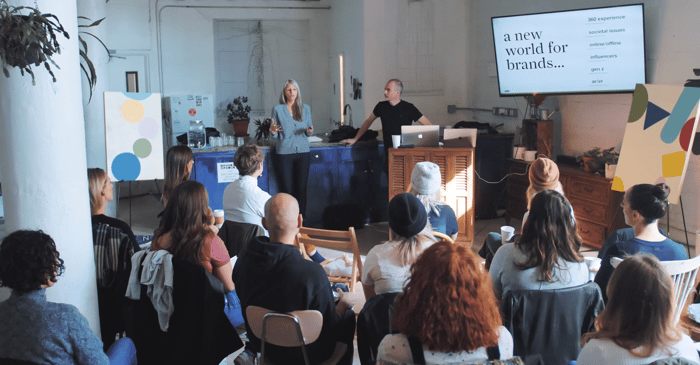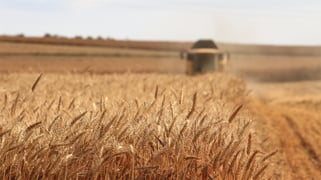Written by
Melissa Lohrer
Building a new brand in a pandemic requires unshakeable confidence.
For Mark and Jen of Bright Future foods, that confidence came from a powerful vision to create something good for people and for the planet. In a little more than a year, these two have led a small but agile team in bringing the first ever climate-positive snack to market.
The process has involved a blend of science and storytelling, optimism and realism, uncertainty and deep-seated belief. Together, we translated a game changing mission, championing agricultural science and conscious consumerism, into something tangible at shelf.
Here’s what they had to say about the journey.
Building a brand in uncertain times
Creating a new brand and product line and introducing a new benefit to a category comes with its risks, even in the best of times. But in the midst of a global pandemic, it requires unwavering trust in what you’re creating.
“From a vision perspective, it’s almost easier because our brand is a belief-driven brand so we know this is the right thing to do. It’s a vote for hope,” says Mark. “Since we’re doing something we firmly believe will make the world a better place, it’s been easy to ignore the noise.”
While innovating during a pandemic world presented its fair share of challenges—supply chain variabilities and lack of consumer contact to name a few—that belief brought both clarity and a willingness to adapt.
“We're creating something we know at our core is good for people, and that’s what matters most,” says Jen. “We’re just going to have to be creative and flexible about how we produce it and get it to retailers.”
Innovating like an entrepreneur
Small team, big disruption, short timeline. It’s a tricky trifecta to achieve. But Mark, Jen, and their team were able to go from zero to finished product (and one that’s generating retailer excitement to boot) in under 18 months.
“We did all of our consumer targeting and insight work in parallel with developing the product and the brand,” says Jen. “That’s not how the process typically works at a big CPG company. Everyone had to be comfortable with the fact that we’re going to learn and pivot along the way.” Mark calls this method—one that’s popular in the tech field—parallel path innovation. Its success and simplicity comes from asking three questions at the same time: does the consumer want it, can we make it, and should we make it?
Mark calls this method—one that’s popular in the tech field—parallel path innovation. Its success and simplicity comes from asking three questions at the same time: does the consumer want it, can we make it, and should we make it?
Translating science into a story
A scientist by training, Mark found himself growing frustrated by the constant debate he was witnessing in the scientific community. Why weren’t scientists taking positions of leadership to ensure their understanding had an impact? Where was the action to back up the rhetoric?
“A big unlock came for us when we found this team of scientists at Colorado State University. In addition to being globally recognized leaders in understanding the carbon footprint of food, they have the belief that improving the way food is grown is necessary to reduce global warming," says Mark.
The group’s company, Soil Metrics, is now working with the brand’s team to talk directly with oat farmers that Bright Future Foods has relationships with.
“We’ve cut out the middlemen and all the layers of bureaucracy, and that’s how we cultivated grains that remove greenhouse gas from the air...something a lot of big companies didn’t think could be done,” says Mark. Translating this science into a story became the next challenge. With lots of brands playing in the organic, farm-to-table space, the story needed to be fresh and authentic. There were so many benefits of the regenerative farming used in creating the product: for the farmers, for the soil, for the consumers.
Translating this science into a story became the next challenge. With lots of brands playing in the organic, farm-to-table space, the story needed to be fresh and authentic. There were so many benefits of the regenerative farming used in creating the product: for the farmers, for the soil, for the consumers.
We partnered with the team to capture a unique story around clean air, taking the consumer’s imagination away from predictable tropes and toward something universal and exciting, and uncovering the language needed to set the brand’s story into motion.
“Telling the story of sequestering carbon at the farm level as you’re holding a snack in your hand is not easy,” says Jen. “Coming up with the language to describe the benefit through easy-to-understand storytelling was some of the most challenging brand work I’ve done, and hence some of the most rewarding.
Purpose-driven and transparent
Having purpose, both Mark and Jen agree, is the key to taking an idea all the way through to a reality. It’s the thing that will get you out of bed in the morning; the guiding light when you’re facing challenges day in and day out. And it needs to be linked fundamentally to your brand—not just slapped on. But even with a clearly defined, deeply rooted “why”, leading with purpose is never easy.
“Transparency is one of our core values. If your purpose is written well, it’s something that’s hard to do,” says Jen. “It’s important to take consumers on the journey with you. Be clear about what you’re doing well and what you wish you were doing better. You can’t do it all on day one.”
Consumers, she says, will be more willing to go on the journey with you if they’re shown respect.
“I’ve seen a lot of purpose-driven companies come across as holier-than-thou or judgmental to those who don’t believe exactly what they do. That’s not the best way to invite people in—it’s limiting your potential,” Jen says. “The days of brands having a one-way conversation with consumers is over. You should be spending as much or more time listening, as trying to get your message out there.”.jpg?width=318&name=ian-schneider-TamMbr4okv4-unsplash%20(3).jpg) To lead authentically with a value-driven brand requires a balance of belief and realism says Mark. Belief in purpose offers the kind of entrepreneurial drive that allows you to stand up for your product in the way no one else can; being realistic about your aspirations allows you to cast aside the notion that you have all of the answers to do the valuable work of being part of a solution.
To lead authentically with a value-driven brand requires a balance of belief and realism says Mark. Belief in purpose offers the kind of entrepreneurial drive that allows you to stand up for your product in the way no one else can; being realistic about your aspirations allows you to cast aside the notion that you have all of the answers to do the valuable work of being part of a solution.
“You’re going to have many critics when you’re an innovator or a visionary,” says Mark. “Ask yourself…are you making a difference? If you believe you’re one of the good guys, that gives you the passion. That links to transparency and allows you to have discussions about how you’re not perfect.”
Being a lighthouse for others
It’s difficult to shift the momentum of an industry—and even harder to shift the momentum of a planet. What is a brand’s role in impacting the world in truly meaningful ways?
“My personal philosophy is that individuals have a responsibility to change the world for the better, and companies are made up of individuals,” says Mark. “What are you going to do with your gifts? It’s always a noble pursuit to put food on the table. But what we’re doing here goes beyond that. Our success in this effort will act as a lighthouse to call others in the food system to follow our lead.”
But if any brand were to change the world, does one that will appear in families’ pantries have a calling of its own to do so? Jen believes so.
“If you’ve developed a brand that has this privilege, you have established a sense of trust, and you’re responsible for doing the right thing,” she says. “A brand is a relationship and you have to continue to invest in that. At minimum, you do no harm and try to push things in the right direction. Companies have the privilege of making a difference.” While there’s no clear-cut answer on what a brand's —or a brand leader’s—responsibility is to make positive change, Mark and Jen are both buoyed by the changes that their new brand is putting into motion.
While there’s no clear-cut answer on what a brand's —or a brand leader’s—responsibility is to make positive change, Mark and Jen are both buoyed by the changes that their new brand is putting into motion.
“This is a vision of what the future of food should be. That’s the way I’m beginning to speak about it,” says Mark. “That vision can live in other brands. It’s a gargantuan idea of how we should live with nature and feed ourselves while healing the earth.”
This new brand is redefining what’s possible and inspiring action. It’s not just an innovation, says Jen. It’s a movement.
This conversation is part of our series on future-ready brands, where we speak with brand leaders about evolving at pivotal moments. See more conversations with future-ready brands.
Follow us on Linkedinand subscribe to our newsletter for more perspectives like these.
Sign up for the latest news and views
